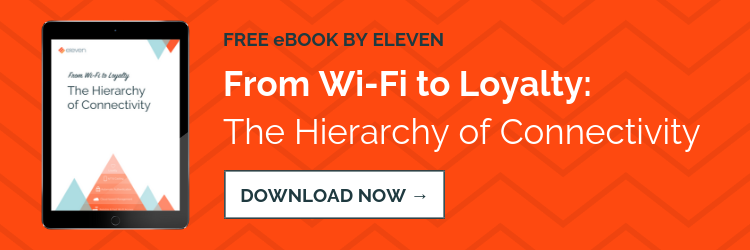-1.png?width=1600&height=900&name=2018-htng-insight-summit-blog-post%20(1)-1.png)
Last week, part of the Eleven team ventured down to Silicon Valley for the 2018 HTNG Insight Summit. It was a week of high-tech learnings and insightful conversations with industry leaders, so we rounded up our top six learnings to share with you.
1. 3G didn’t kill Wi-Fi® and neither will 5G
While 5G is an important improvement in connectivity, it is not expected to replace Wi-Fi now or in the foreseeable future. Instead, Wi-Fi and 5G will coexist in our increasingly connected world and travelers will use them interchangeably, likely without noticing (or caring about) a difference as long as they're connected always and everywhere. More specifically, Wi-Fi still beats 5g indoors. The Wi-Fi market is estimated to be worth 15.60 Billion USD by the year 2022–indicative of a market that is growing, not slowing. Wi-Fi still has its place, particularly for enterprises.
2. Wi-Fi 6 is just around the corner
Technically called 802.11ax, Wi-Fi 6 is a new type of WLAN designed to operate in the already existing 2.4 GHz and 5 GHz spectrums. The Wi-Fi Alliance® recently announced the simplified numbering system they'll now use to identify versions (instead of 802.11ac, etc). Each generation of Wi-Fi delivers faster speeds and increased throughput. Wi-Fi 6, set to be released in 2019, will deliver an improved experience to address device and application needs in a range of consumer and enterprise environments.
3. CBRS is bringing hybrid networks to life
Citizens Broadband Radio Service (CBRS) is a broadcast band that was historically used by the US government for radar systems and was recently freed up. By eliminating the choice between licensed and unlicensed airwaves, CBRS is the "best of both worlds" for wireless. It will not only enhance service provider LTE, but could potentially enable enterprises to build their own private LTE networks (source). For hotels, that could help with the guest experience by eliminating dead zones and bringing us one step closer to a truly frictionless Wi-Fi experience.
4. Wi-Fi security is no longer the elephant in the room
From GDPR to the California Privacy Act to Mark Zuckerberg's 4-hour testimony in front of senate, online privacy and Wi-Fi security has recently become more important–and visible–than ever. Historically, the industry has talked about security as an intangible idea that we need to address. This year, we have seen the technology catching up. From Passpoint and WPA3 to new innovations from WFA, network specifications and enhancements will make for a better, more secure Wi-Fi experience across the board.
5. Simplicity is key for hotel network infrastructure
Disparate systems across new and old properties, more stringent brand requirements, and new network technologies are just a few of the challenges hoteliers face in regards to Wi-Fi. A typical property has separate networks for phone, Internet, TV, etc. In a perfect world, these would all be converged into a "core network" managed by a central authentication and Wi-Fi management platform, like ElevenOS.
6. We could see a 'Guest Wi-Fi Index' in 2019
By now, we all know about the speed tests on hotelwifitest.com, but we also know that bandwidth is just part of the guest Wi-Fi experience. To make the experience frictionless and easy, there are several other factors beyond speed including the captive portal, authentication process, multi-device onboarding, and content casting.
If HTNG's newest workgroup, Improving the Guest Wi-Fi Experience, tells us anything, it's that Wi-Fi is more crucial than ever to the guest experience. In 2019 we predict we'll see the industry come together to address what truly constitutes best practice for hotel Wi-Fi and how we can measure it.
